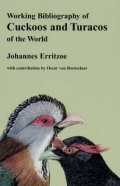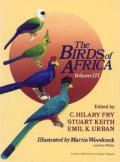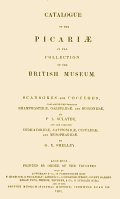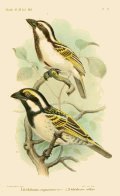On this page
Books about TuracosThis page lists books that are totally or partially about Turacos. The books are listed in order of publication date with the most recent at the top.
Turacos
Turacos are part of the Musophagidae family which also includes plantain-eaters and go-away-birds. The species that comprise the family are listed below. Turacos are restricted to sub-Saharan Africa.
Guinea Turaco
Tauraco persa
Livingstone's Turaco
Tauraco livingstonii
Schalow's Turaco
Tauraco schalowi
Knysna Turaco
Tauraco corythaix
Black-billed Turaco
Tauraco schuettii
White-crested Turaco
Tauraco leucolophus
Fischer's Turaco
Tauraco fischeri
Yellow-billed Turaco
Tauraco macrorhynchus
Bannerman's Turaco
Tauraco bannermani
Red-crested Turaco
Tauraco erythrolophus
Hartlaub's Turaco
Tauraco hartlaubi
White-cheeked Turaco
Tauraco leucotis
Ruspoli's Turaco
Tauraco ruspolii
Purple-crested Turaco
Tauraco porphyreolophus
Ruwenzori Turaco
Ruswenzorornis johnstoni
Violet Turaco
Musophaga violacea
Ross's Turaco
Musophaga rossae
Great Blue Turaco
Corythaeola cristata
Bare-faced Go-away-bird
Corythaixoides personatus
Grey Go-away-bird
Corythaixoides concolor
White-bellied Go-away-bird
Corythaixoides leucogaster
Western Plantain-eater
Crinifer piscator
Eastern Plantain-eater
Crinifer zonurus
|
|
|
|
Turacos: A Natural History of the MusophagidaeJoseph M. Forshaw
Illustrations: William T. Cooper
Nokomis Editions
2002
"With publication by Nokomis Editions of Turacos: A Portfolio of All Species the masterful paintings by William Cooper were, for the first time, reproduced at their original size. This placed primary focus on the remarkable illustrations of all species in one of the world's most spectacular bird groups, and the accompanying text by Joseph Forshaw was written to complement the illustrations. Nokomis Editions now proudly announces publication of Turacos: A Natural History of the Musophagidae, in which emphasis is placed on the many fascinating aspects of the natural history of these spectacularly beautiful birds, with three new plates from William Cooper. Prompted by a recent upsurge of interest and research, which have produced much new information about turacos, Joseph Forshaw has prepared an entirely new text covering physical attributes, taxonomy, distribution, habitat preferences and the general ecology of all species, and he points out that, despite our improving knowledge, an element of mystery still surrounds these birds. Poor fossil records hinder our understanding of their evolutionary history and affinities with other birds. Despite several attempts to link the family with other groups, the traditional approach is to place them alone in a separate order, so emphasising their distinctiveness. The most distinctive feature is the presence in their plumage of two complex copper pigments not known to occur in any other living animal, and we are compelled to ask why are these pigments present? Also, how important are visually minor differences in facial pattern for species recognition? Are differences in bill shapes associated with foraging techniques, and what roles do subtle differences in diet play in allowing species lo coexist? What functions are served by the loud, familiar call-notes, and what courtship rituals are in place? Why should the downy chicks be equipped with wing-claws to enable them to clamber amidst branches well before they can fly? These and other queries are addressed in this scholarly work, which is the first fully illustrated monograph to be published since 1860 and the only volume covering all species."
|
 |
|
Working Bibliography of Cuckoos and Turacos of the WorldJohannes Erritzoe and Oscar van Rootselaar
Sponsored by The Danish Ministry of Research and Information Technology, Copenhagen
2000
A 400 page bibliography. Includes a CD-ROM containing the whole reference list for quick searching.
|
 |
|
Turacos: A Portfolio of All SpeciesWilliam T. Cooper
Limited edition: 290 hand numbered sets
Nokomis Editions
1997
The Portfolio consists of 23 colour plates presented in a beautifully crafted hand made Solander box. The accompanying text by Joseph M. Forshaw is enclosed in a separate cased volume within the Solander box. Each plate is reproduced to its original size, which is 750 mm x 570 mm. The plates were subsequently used in the book Turacos: A Natural History of the Musophagidae.
|
 |
|
Handbook of the Birds of the World, Vol. 4: Sandgrouse to CuckoosEdited by Josep Del Hoyo, Andrew Elliott and Jordi Sargatal
Lynx Edicions
1997
680 pages, 70 colour plates, 250 colour photos, 850 distribution maps.
This volume covers sandgrouse, pigeons and doves, cockatoos, parrots, turacos and cuckoos.
|
Buy from amazon.co.uk 
|
|
The Birds of Africa, Volume III: Parrots to WoodpeckersEditors: C Hilary Fry, Stuart Keith and Emil K Urban
Illustrations: Martin Woodcock and Ian Willis
Poyser
1988
"This volume completes the non-passerines, dealing with all species occurring on the continent - residents and visitors alike - in the following families: parrots, turacos, cuckoos, owls, nightjars, swifts, colies, kingfishers and their allies, and woodpeckers and their allies. All are illustrated, and all known biological information is included."
|
Buy from amazon.co.uk 
|
|
Catalogue Of The Picariae In The Collection Of The British MuseumCatalogue Of The Birds In The British Museum, Volume XIX
Scansores and Coccyges: P.L. Sclater
Indicatoridae, Capitonidae, Cuculidae and Musophagidae: G.E. Shelley
Colour plates: J. Smit (4), J.G. Keulemans (9)
Printed By Order Of The Trustees
Sold by: Longman & Co.; B. Quaritch; Kegan Paul, Trench, Trubner & Co.; and at the British Museum (Natural History)
1891
From the preface: "The present volume contains an account of the remaining families of the suborder Scansores, and of those of the suborder Coccyges. The arrangement of three of these families, which are entirely composed of Neotropical forms, was undertaken by Mr. P. L, Sclater, that of the remainder by Captain G. E. Shelley. The numbers of species of the several families, and of the specimens at present in the Collection of the British Museum, are as follows: Indicatoridae, 12; Capitonidae, 112; Rhamphastidae, 59; Galbulidae, 21; Bucconidae, 43; Cuculidae, 176; Musophagidae, 25. Of the 448 species recorded, 32 are not represented in the Museum; but besides the 73 types of species admitted as valid, the Collection contains 50 other typical specimens the names of which are now relegated to the synonymic lists. Of donations not already mentioned on former occasions, I have to refer to the two following, which were specially useful in supplementing the series of specimens catalogued in the present volume: the entire collection of Cuckoos formed by Mr. H. Seebohm, and consisting of 539 specimens; and a valuable series of South-African birds collected by T. and W. Ayres in Natal and the Transvaal for the late Mr. J. H. Gurney, and presented by his son."
|


 |
|